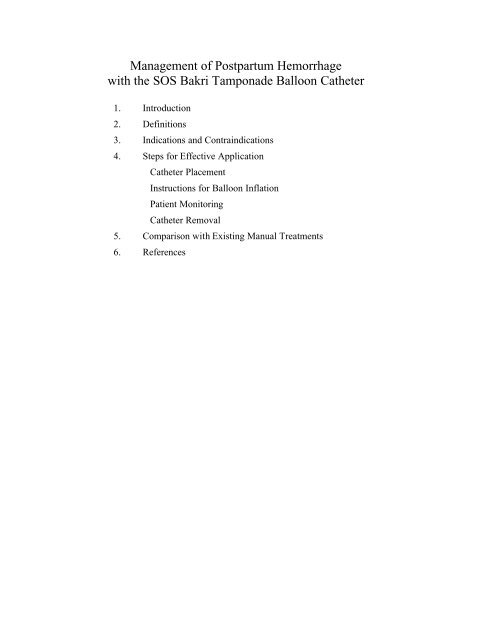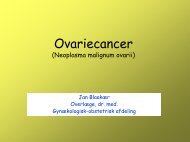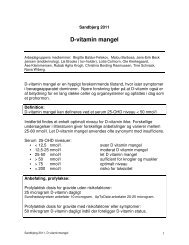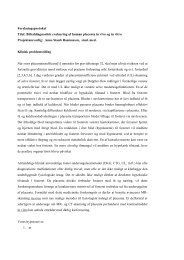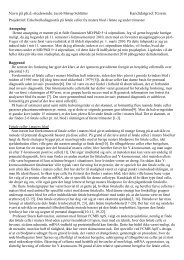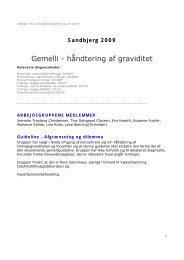Bakri SOS Tamponade Balloon Inservice Handout
Bakri SOS Tamponade Balloon Inservice Handout
Bakri SOS Tamponade Balloon Inservice Handout
Create successful ePaper yourself
Turn your PDF publications into a flip-book with our unique Google optimized e-Paper software.
Management of Postpartum Hemorrhage<br />
with the <strong>SOS</strong> <strong>Bakri</strong> <strong>Tamponade</strong> <strong>Balloon</strong> Catheter<br />
1. Introduction<br />
2. Definitions<br />
3. Indications and Contraindications<br />
4. Steps for Effective Application<br />
Catheter Placement<br />
Instructions for <strong>Balloon</strong> Inflation<br />
Patient Monitoring<br />
Catheter Removal<br />
5. Comparison with Existing Manual Treatments<br />
6. References
Management of Postpartum Hemmorhage<br />
1. Introduction: The Problem of Obstetrical Bleeding -- Management and<br />
Conservation<br />
Obstetrical bleeding (intrapartum/postpartum) secondary to placenta previa with variable degrees of<br />
accretism is not uncommon. Postpartum bleeding is bleeding that occurs immediately after the<br />
placenta is delivered. With an incidence of one in twenty deliveries, it is one of the leading causes<br />
of maternal mortality 10, 11 .<br />
Although various management measures are utilized for control of bleeding caused by this clinical<br />
abnormality the conservative approach is becoming increasingly used instead of hysterectomy.<br />
Hysterectomy can be an undesirable action to take, and this is especially true in the case of a low<br />
parity patient. Usually, this step is taken when other traditional measures to stop hemorrhage fail 4 .<br />
Uterine packing has been used successfully in many cases to conservatively manage postpartum<br />
bleeding; however, removing such packing can sometimes require a separate surgical procedure to<br />
dilate and extract the materials. Therefore, packing sometimes falls short of an ideal treatment<br />
option.<br />
The ideal choice for managing a patient’s postpartum hemorrhage might offer control of<br />
capillary/venous bleeding and surface oozing in order to avoid hysterectomy to preserve the<br />
patient’s reproductive potential.<br />
Cook Ob/Gyn has designed such a device that will aid in the conservative management of<br />
postpartum hemorrhage when other conservative agents might have failed. The <strong>SOS</strong> <strong>Bakri</strong><br />
<strong>Tamponade</strong> <strong>Balloon</strong> Catheter by Cook Ob/Gyn is easily administered, and removes as easily as it is<br />
applied, thus removing the need for a separate surgical procedure to remove tamponade agents.<br />
2. Definitions<br />
Placenta Previa:<br />
Placenta Accreta:<br />
Postpartum:<br />
Embolization:<br />
Abruptio<br />
Placentae:<br />
Uterine Atony:<br />
Primigravida:<br />
Consumption<br />
Coagulopathy:<br />
Condition in which the placenta is implanted in the lower segment of the<br />
uterus and covers the cervical opening either partly or completely.<br />
Condition in which the placenta infiltrates the lining of the uterus (decidua)<br />
and implants into the tissue of the cervix or the myometrium (muscle of the<br />
body of the uterus) making it difficult for the placenta to separate after<br />
delivery of the baby.<br />
Pertaining to, or occurring after childbirth.<br />
The introduction of certain substances into vessels and arteries for the<br />
therapeutic occlusion of vasculature.<br />
Premature separation of the normally implanted placenta from its uterine<br />
attachment.<br />
Loss of muscular tone of the uterus, which may result in failure of progress of<br />
labor or postpartum hemorrhage.<br />
A woman in her first pregnancy.<br />
A condition marked by great reduction in the circulating levels of platelets and<br />
of certain coagulation factors due to the utilization of platelets in excessive<br />
- 1 -
<strong>SOS</strong> <strong>Bakri</strong> <strong>Tamponade</strong> <strong>Balloon</strong> Catheter<br />
blood clots throughout the body.<br />
Logothetopulos:<br />
Morbidity:<br />
The name of a Greek obstetrician who described a plastic infusion bag filled<br />
with sponge to work as a packing of the uterus.<br />
The condition of being diseased or morbid, also the sick rate.<br />
3. Indications for use of the <strong>SOS</strong> <strong>Bakri</strong> <strong>Tamponade</strong> <strong>Balloon</strong> Catheter<br />
The <strong>SOS</strong> <strong>Bakri</strong> <strong>Tamponade</strong> <strong>Balloon</strong> Catheter is intended to provide temporary control or reduction<br />
of postpartum uterine bleeding when conservative management is warranted.<br />
While the device is intended as a temporary means of establishing hemostasis in cases indicating<br />
conservative management of postpartum uterine bleeding, the application of this device should be<br />
concomitant with close monitoring for signs of arterial bleeding, atony bleeding, and/or<br />
disseminated intravascular coagulation (DIC).<br />
The use of this product is contraindicated in the presence of:<br />
• arterial bleeding requiring surgical exploration or angiographic embolization.<br />
• uterine atony bleeding.<br />
• cases indicating hysterectomy.<br />
• pregnancy.<br />
• cervical cancer.<br />
• purulent infections of the vagina, cervix, or uterus.<br />
• untreated uterine anomaly.<br />
• disseminated intravascular coagulation.<br />
• a surgical site which would prohibit the device from effectively controlling bleeding.<br />
Close patient monitoring is required at all times during balloon use.<br />
4. Steps For Effective Application<br />
Catheter Placement<br />
Vaginal Delivery -- Transvaginal Placement<br />
1. Determine uterus is clear of any retained placental fragments, arterial bleeding, or<br />
lacerations.<br />
2. Determine approximate uterine volume by ultrasound or direct examination.<br />
3. Insert the balloon portion of the catheter in the uterus, making certain that the entire<br />
balloon is inserted past the cervical canal and internal ostium, under ultrasound<br />
guidance.<br />
4. Caution: Avoid excessive force when inserting the balloon into the uterus.<br />
5. If not already indwelling, place a Foley catheter in patient bladder to collect and monitor<br />
urine output.<br />
- 2 -
Management of Postpartum Hemmorhage<br />
6. To ensure maintenance of correct placement and maximize tamponade effect, the<br />
vaginal canal may be packed with iodine or antibiotic soaked vaginal gauze at this time.<br />
Cesarean Delivery -- Transabdominal Placement<br />
1. Determine uterus is clear of any retained placental fragments, arterial bleeding, or<br />
lacerations.<br />
2. Determine uterine volume by intraoperative direct examination or postoperative<br />
ultrasound examination.<br />
3. From above (via access of the Cesarean incision), pass the tamponade balloon, inflation<br />
port first, through the uterus and cervix.<br />
4. Have an assistant pull the shaft of the balloon through the vaginal canal until the deflated<br />
balloon base comes in contact with the internal cervical ostium.<br />
5. Close the incision per normal procedure, taking care to avoid puncturing the balloon<br />
while suturing.<br />
6. If not already indwelling, place a Foley catheter in patient bladder to collect and monitor<br />
urine output.<br />
7. To ensure maintenance of correct placement and maximize tamponade effect, the<br />
vaginal canal may be packed with iodine or antibiotic soaked vaginal gauze at this time.<br />
Instructions for <strong>Balloon</strong> Inflation<br />
1. Warning: Always inflate the balloon with sterile liquid. Never inflate with air, carbon<br />
dioxide or any other gas.<br />
2. Warning: Do not over inflate the balloon. Please refer to product label for maximum<br />
inflation volume.<br />
3. Ensure that indwelling Foley is placed in patient bladder at this time.<br />
4. To ensure that the balloon is filled to the desired volume, it is recommended that the<br />
predetermined volume of fluid be placed in a separate container, rather than solely relying<br />
on a syringe count to verify the amount of fluid that has been instilled into the balloon.<br />
5. Using the enclosed syringe, begin filling the balloon to the predetermined volume through<br />
the stopcock.<br />
6. Apply gentle traction to the balloon shaft to ensure proper contact between the balloon and<br />
tissue surface. To maintain tension, secure the balloon shaft to the patient’s leg or attach to a<br />
weight, not to exceed 500 grams.<br />
7. Note: If balloon becomes dislodged due to shaft tension and cervical dilation, deflate,<br />
reposition, and reinflate. Use of vaginal packing may be indicated at that time to aid in<br />
balloon placement.<br />
- 3 -
<strong>SOS</strong> <strong>Bakri</strong> <strong>Tamponade</strong> <strong>Balloon</strong> Catheter<br />
Patient Monitoring<br />
1. Once balloon is placed and is inflated, connect the drainage port to a fluid collection bag to<br />
monitor hemostasis.<br />
2. IMPORTANT: To adequately monitor hemostasis, the balloon drainage port and<br />
tubing should be flushed clear of clots with sterile isotonic saline.<br />
3. Patient should be monitored continuously for signs of increased bleeding, uterine cramping,<br />
or a deteriorating condition.<br />
4. Patient monitoring should include, but not be limited to: blood pressure, pulse, urine output,<br />
cramping, pallor, and active bleeding.<br />
5. IMPORTANT: Signs of deteriorating or non-improving conditions should indicate<br />
more aggressive treatment and management of patient uterine bleeding.<br />
6. IMPORTANT: This device is not a substitute for surgical management and fluid<br />
resuscitation of life-threatening postpartum hemorrhage.<br />
Catheter Removal<br />
Maximum indwell time is twenty-four (24) hours. <strong>Balloon</strong> may be removed sooner upon<br />
physician determination of hemostasis or need to apply more aggressive treatment.<br />
1. Remove tension from balloon shaft.<br />
2. Remove any vaginal packing.<br />
3. Using an appropriate syringe, aspirate the contents of the balloon until fully deflated.<br />
4. Gently retract the balloon from the uterus and vaginal canal and discard.<br />
5. Continue to monitor the patient for signs of uterine bleeding.<br />
5. Comparison with Existing Manual Treatments<br />
<strong>Bakri</strong> <strong>Balloon</strong> Catheter vs. Uterine Packing<br />
The use of uterine packing for management of obstetrical hemorrhage has had both supporters<br />
and detractors. While the material cost of packing is nominal there are some concerns voiced<br />
about treatment capabilities and follow up. In general, these concerns include clot adhesion,<br />
concealed hemorrhaging, no record of blood loss, and uterine trauma.<br />
Use of uterine packing has been believed to help conceal a hemorrhage in the uterine cavity. 10<br />
Even if a hemorrhage were concealed, it might be evident immediately after the procedure. The<br />
use of such packing for PPH does generally present little risk to the patient, but removal can be<br />
painful. Sometimes uterine packing must be removed in a surgical setting and/or under<br />
anesthetic.<br />
- 4 -
Management of Postpartum Hemmorhage<br />
The <strong>Bakri</strong> balloon may be used quickly without anesthetic, and removes quite simply once<br />
deflated. The patent lumen in the balloon shaft allows for direct measurement of continued<br />
blood loss. Therefore, the likelihood of a concealed hemorrhage going undetected or delayed<br />
detection is diminished. Because the balloon is silastic and conforms to uterine shape/volume,<br />
there is less concern of uterine trauma. The nature of the silicone balloon is that it will deform<br />
more easily than perforate uterine tissue.<br />
<strong>Bakri</strong> <strong>Balloon</strong> Catheter vs. Sengstaken-Blakemore <strong>Balloon</strong> or Foley Catheters<br />
The Sengstaken-Blakemore balloon is a naso-gastric balloon for tamponade of esophageal<br />
varicoceles and the introduction of contrast media. This balloon contains latex, does not<br />
necessarily take uterine shape, and is not specifically intended for application in the uterus.<br />
Foley catheters are generally inexpensive, but are generally ineffective in a large uterine cavity.<br />
Their use tends to require application of multiple Foleys simultaneously. If they are applied<br />
individually (no overbag), they do not readily conform to uterine anatomy; and therefore, the<br />
potential for effective site-specific tamponade can be compromised. If they are applied jointly in<br />
a plastic covering or overbag, this does not allow for proper drainage, and can conceal uterine<br />
hemorrhage. In general, the application of multiple Foleys is cumbersome and less effective<br />
than the <strong>Bakri</strong> balloon.<br />
The <strong>Bakri</strong> balloon is 100% silicone (no latex), and has a ductile shape which allows it to<br />
conform to the uterine anatomy. It allows for hemostatic cushion application, and limits clot<br />
adhesion. The large diameter lumen in the shaft and multi-ported, non-abrasive tip allows for<br />
constant drainage, so an ongoing uterine hemorrhage does not go undetected post-application.<br />
Its pull-strength allows for the application of up to 500g of tension to aid tamponade<br />
achievement. Finally, once deflated the <strong>Bakri</strong> balloon is easily removed transvaginally without<br />
the need for an additional surgical procedure.<br />
6. References<br />
If you wish to find more about the treatment options for Postpartum Hemorrhage, the following<br />
references cover the many treatment options for this complication.<br />
1. <strong>Bakri</strong> YN, et al. <strong>Tamponade</strong>-balloon for obstetrical bleeding. Int. J. Gynecol. Obstet.<br />
2001; 74: 139-142.<br />
2. G. S. Condous, et al. The “<strong>Tamponade</strong> Test” in the Management of Massive Postpartum<br />
Hemorrhage. Obstetrics and Gynecology (2003) Vol. 101, No. 4:767-772.<br />
3. <strong>Bakri</strong> YN. <strong>Balloon</strong> device for control of obstetrical bleeding. Euro J Obstet Gynecol<br />
Reprod Biol. 1999; 86:S84.<br />
4. Zaki M.S. Zaki, et al. Risk factors and morbidity in patients with placenta previa accrete<br />
compared to placenta previa non-accreta. Acta Obset Gynecol Scand 1998; 77: 391-394.<br />
5. Soloman Isayu, et al. The epidemiology of placenta previa in the United States, 1979<br />
through 1987. Am J Obstet Gynecol., Vol. 168, No. 5.<br />
6. S.J. Etuk, et al. Maternal mortality following PPH in Calabar: A 6 year review. WAJM<br />
Vol. 16, No. 3, August-September 1997.<br />
- 5 -
<strong>SOS</strong> <strong>Bakri</strong> <strong>Tamponade</strong> <strong>Balloon</strong> Catheter<br />
7. Manyonda I.T., et al. Massive obstetric hemosshae due to placenta previa/accrete with<br />
prior cesarian section. Int. J Gynecol. Obstet., 1990, 34: 183-6.<br />
8. McShane P, et al. Maternal and perinatal morbidity resulting from placenta previa.<br />
Obstet Gynecol., 1985; 65: 176.<br />
9. Clark S, et al. Placenta previa/accrete and prior cesarian section. Obstet Gynecol.<br />
1985; 66:89.<br />
10. Maier R. Control of postpartum hemorrhage with uterine packing. Am J Obstet<br />
Gynecol. 1993; 169: 317-23.<br />
11. Wittich A, et al. Uterine packing in the combined management of obstetrical<br />
hemorrhage. Military Medicine, Vol. 161, March 1996.<br />
12. <strong>Bakri</strong> Y.N., Uterine tamponade-drain for hemorrhage secondary to placenta previaaccreta.<br />
Int J Gynecol Obstet., 1992; 37.<br />
13. De Loor J., et al. Foley catheters for uncontrollable obstetric or gynecologic<br />
hemorrhage. Obstet Gynecol., 1996; 88-737.<br />
14. Robie G. Logothetopulos pack for the management of uncontrollable postpartum<br />
hemorrhage. Am J Perinatology. 1990; Vol. 7: No. 4.<br />
15. Wax J. Packing of the lower uterine segment-new approach to an old technique. Int J<br />
Gynecol Obstet., 1993; #43.<br />
16. Hallack M. Transvaginal pressure pack for life-threatening pelvic hemorrhage secondary<br />
to placenta accrete. Obstet Gynecol., Nov. 1991; 78, No.5, Part 2.<br />
17. Katesmart M., et al. Successful use of a Sengstaken-Blakemore tube to control massive<br />
postpartum haemorrhage. British J Gynecol Obstet., March 1994; Vol. 101: 259-60.<br />
- 6 -


